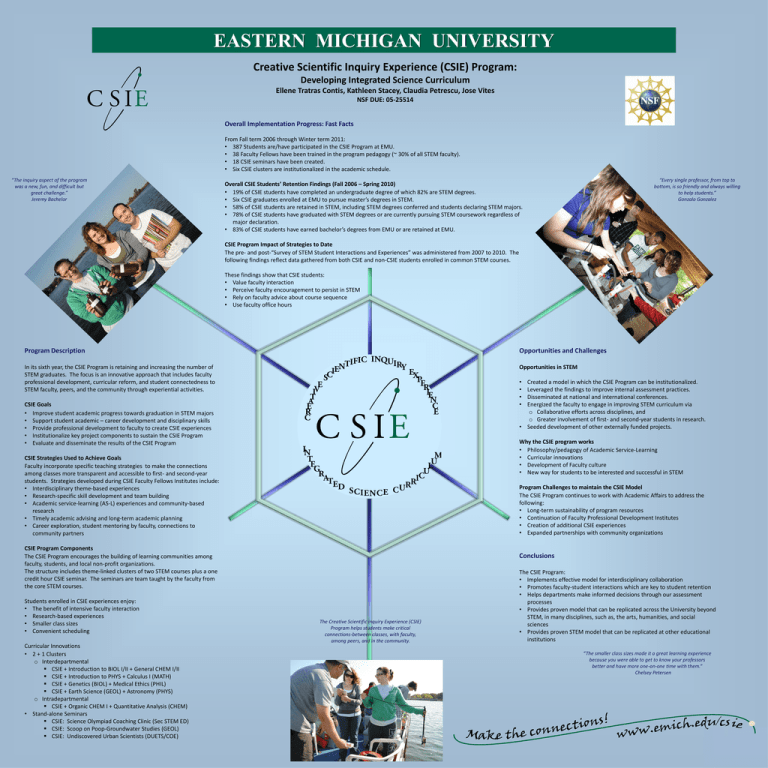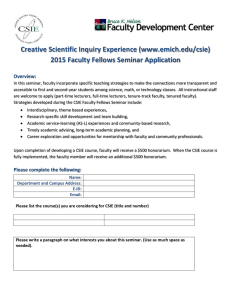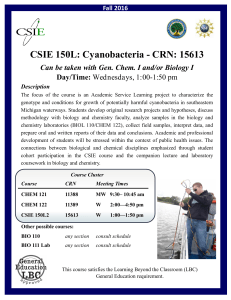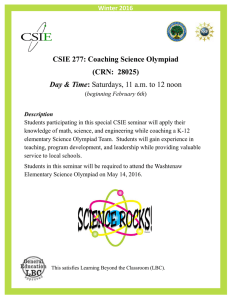Document 13589028
advertisement

EASTERN MICHIGAN UNIVERSITY Creative Scientific Inquiry Experience (CSIE) Program: Developing Integrated Science Curriculum Ellene Tratras Contis, Kathleen Stacey, Claudia Petrescu, Jose Vites NSF DUE: 05-25514 Overall Implementation Progress: Fast Facts From Fall term 2006 through Winter term 2011: • 387 Students are/have participated in the CSIE Program at EMU. • 38 Faculty Fellows have been trained in the program pedagogy (~ 30% of all STEM faculty). • 18 CSIE seminars have been created. • Six CSIE clusters are institutionalized in the academic schedule. “The inquiry aspect of the program was a new, fun, and difficult but great challenge.” Jeremy Bachelor “Every single professor, from top to bottom, is so friendly and always willing to help students.” Gonzalo Gonzalez Overall CSIE Students’ Retention Findings (Fall 2006 – Spring 2010) • 19% of CSIE students have completed an undergraduate degree of which 82% are STEM degrees. • Six CSIE graduates enrolled at EMU to pursue master’s degrees in STEM. • 58% of CSIE students are retained in STEM, including STEM degrees conferred and students declaring STEM majors. • 78% of CSIE students have graduated with STEM degrees or are currently pursuing STEM coursework regardless of major declaration. • 83% of CSIE students have earned bachelor’s degrees from EMU or are retained at EMU. CSIE Program Impact of Strategies to Date The pre- and post-“Survey of STEM Student Interactions and Experiences” was administered from 2007 to 2010. The following findings reflect data gathered from both CSIE and non-CSIE students enrolled in common STEM courses. These findings show that CSIE students: • Value faculty interaction • Perceive faculty encouragement to persist in STEM • Rely on faculty advice about course sequence • Use faculty office hours Program Description Opportunities and Challenges In its sixth year, the CSIE Program is retaining and increasing the number of STEM graduates. The focus is an innovative approach that includes faculty professional development, curricular reform, and student connectedness to STEM faculty, peers, and the community through experiential activities. Opportunities in STEM • • • • Created a model in which the CSIE Program can be institutionalized. Leveraged the findings to improve internal assessment practices. Disseminated at national and international conferences. Energized the faculty to engage in improving STEM curriculum via o Collaborative efforts across disciplines, and o Greater involvement of first- and second-year students in research. • Seeded development of other externally funded projects. CSIE Goals • Improve student academic progress towards graduation in STEM majors • Support student academic – career development and disciplinary skills • Provide professional development to faculty to create CSIE experiences • Institutionalize key project components to sustain the CSIE Program • Evaluate and disseminate the results of the CSIE Program Why the CSIE program works • Philosophy/pedagogy of Academic Service-Learning • Curricular innovations • Development of Faculty culture • New way for students to be interested and successful in STEM CSIE Strategies Used to Achieve Goals Faculty incorporate specific teaching strategies to make the connections among classes more transparent and accessible to first- and second-year students. Strategies developed during CSIE Faculty Fellows Institutes include: • Interdisciplinary theme-based experiences • Research-specific skill development and team building • Academic service-learning (AS-L) experiences and community-based research • Timely academic advising and long-term academic planning • Career exploration, student mentoring by faculty, connections to community partners Program Challenges to maintain the CSIE Model The CSIE Program continues to work with Academic Affairs to address the following: • Long-term sustainability of program resources • Continuation of Faculty Professional Development Institutes • Creation of additional CSIE experiences • Expanded partnerships with community organizations CSIE Program Components The CSIE Program encourages the building of learning communities among faculty, students, and local non-profit organizations. The structure includes theme-linked clusters of two STEM courses plus a one credit hour CSIE seminar. The seminars are team taught by the faculty from the core STEM courses. Students enrolled in CSIE experiences enjoy: • The benefit of intensive faculty interaction • Research-based experiences • Smaller class sizes • Convenient scheduling Curricular Innovations • 2 + 1 Clusters o Interdepartmental CSIE + Introduction to BIOL I/II + General CHEM I/II CSIE + Introduction to PHYS + Calculus I (MATH) CSIE + Genetics (BIOL) + Medical Ethics (PHIL) CSIE + Earth Science (GEOL) + Astronomy (PHYS) o Intradepartmental CSIE + Organic CHEM I + Quantitative Analysis (CHEM) • Stand-alone Seminars CSIE: Science Olympiad Coaching Clinic (Sec STEM ED) CSIE: Scoop on Poop-Groundwater Studies (GEOL) CSIE: Undiscovered Urban Scientists (DUETS/COE) Conclusions The Creative Scientific inquiry Experience (CSIE) Program helps students make critical connections-between classes, with faculty, among peers, and in the community. The CSIE Program: • Implements effective model for interdisciplinary collaboration • Promotes faculty-student interactions which are key to student retention • Helps departments make informed decisions through our assessment processes • Provides proven model that can be replicated across the University beyond STEM, in many disciplines, such as, the arts, humanities, and social sciences • Provides proven STEM model that can be replicated at other educational institutions “The smaller class sizes made it a great learning experience because you were able to get to know your professors better and have more one-on-one time with them.” Chelsey Petersen printed by www.postersession.com


